All The Ways The F-35 Tried To Kill Its Pilot Prior To Eglin AFB Crash
The pilot of the U.S. Air Force F-35A stealth fighter that crashed at Eglin Air Force Base in Florida this past summer struggled with an extraordinary catalog of problems before he ejected from the jet. Though high-landing speed was determined to be the key culprit, issues with the pilot’s helmet, the aircraft’s oxygen system, and the software behind the jet’s fly-by-wire flight control system all contributed to the accident, according to a recently released official report.
The F-35A from the 58th Fighter Squadron, the “Gorillas,” part of the 33rd Fighter Wing, crashed upon landing at the Florida base on May 19, 2020, after a routine night-training sortie. It was the second crash of a stealth fighter operating out of the base in less than a week, following the loss of an F-22 Raptor on May 15, and the two accidents led to a “safety pause” on flying operations at the base.
In its conclusion to the report, the Accident Investigation Board President, Colonel Bryan T. Callahan, makes it clear that no fewer than six factors led to the loss of the F-35. The key factor to come out of the investigation was the fact that the pilot was attempting to land the Lightning II at an excessive speed. However, the tail was also unresponsive due to a problem with the flight-control logic that wasn’t widely known up to that point.
There are other disturbing issues outlined in the final report, among them numerous errors made by the pilot — a qualified instructor who was flying as lead for the two-ship training sortie — in the run-up to the crash. The aviator was fatigued, in part due to issues with the jet’s “on-demand” oxygen system, leading to “cognitive degradation,” while a misaligned helmet-mounted display meant that he was distracted at a critical point, as well.
After ejecting, the pilot sustained non-life-threatening injuries and was transported to the 96th Medical Group Hospital for evaluation and monitoring.
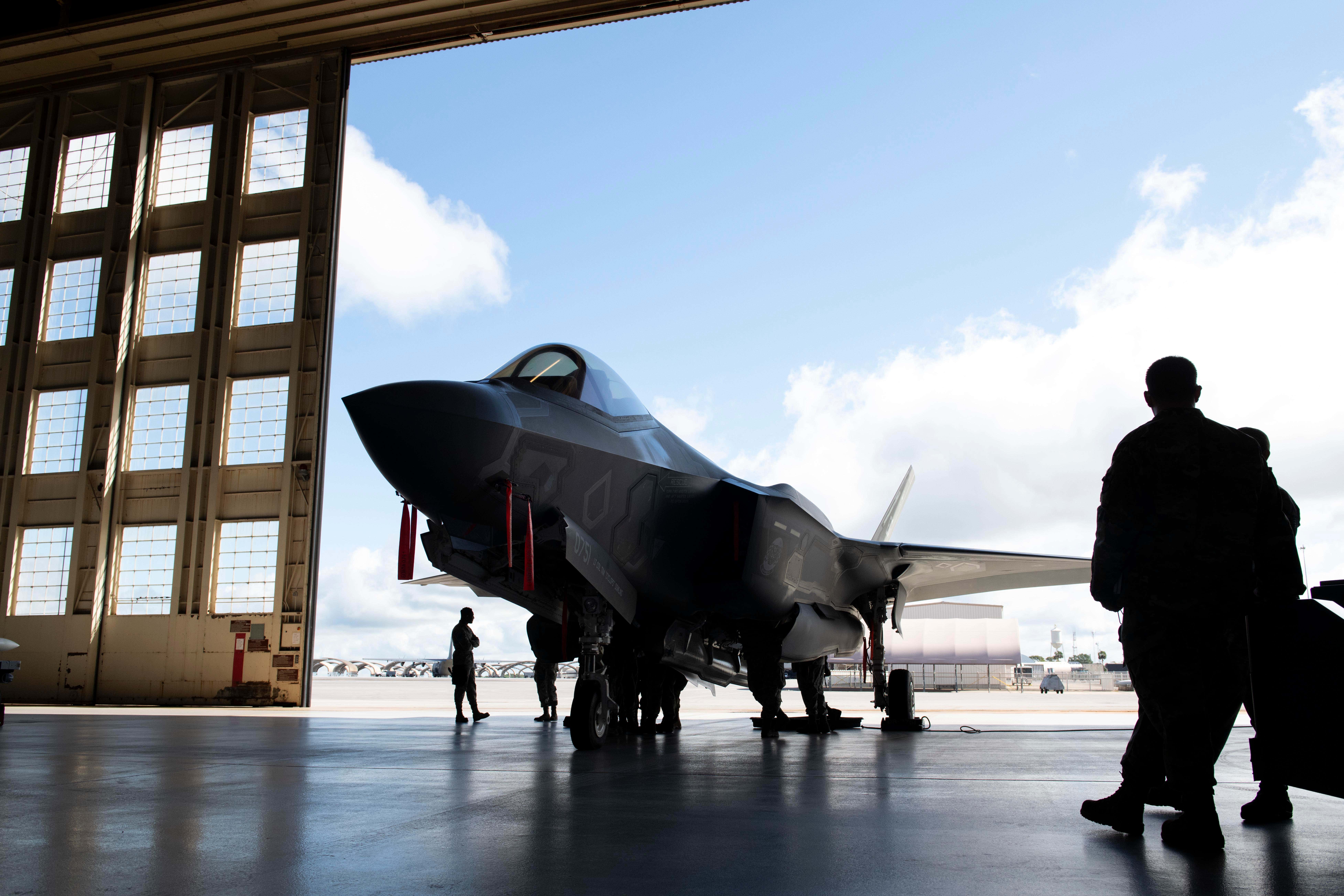
U.S. AIR FORCE/SENIOR AIRMAN CASSIDY WOODY
Weapons load crew from the 33rd Fighter Wing prepare an F-35A at Eglin Air Force Base, Florida.
Exactly how the third F-35 crash unfolded is worth looking at in more detail, with a close examination of the accident report.
At the controls of the F-35A in question, serial 12-005053, the mishap pilot (MP) maintained a steady speed of 202 knots on the approach — this was correct for this phase of flight, but would be a major contributor in the accident later on. Meanwhile, problems were beginning to make themselves known, distracting the pilot from the task at hand.
First, the pilot noticed that his helmet-mounted display (HMD) seemed to be misaligned in relation to the horizon. The F-35 does not have a traditional fixed head-up display (HUD), as found on a typical legacy fighter, but instead projects that data directly onto the helmet’s visor. The Joint Strike Fighter has had issues in the past with its HMD, including with the alignment and clarity of the information presented.
“The MP was fixated on the faulty symbology of the HMD at a critical phase of flight to the exclusion of a crosscheck of either AOA or airspeed,” the report noted.
As well as the misalignment, the pilot was struggling with what seemed like excessive brightness, making it more difficult to focus. This was a result of the “green glow” phenomenon in the cockpit, created by the HMD’s projection brightness, and now made worse since it was combined with local humidity. “The [pilot] reported having to squint through the green glow in order to pick up on the environmental cues in the runway environment,” the report stated.
After checking the virtual head-up display against data from the instrument landing system, he then adjusted his aim point and glideslope as the jet neared the runway threshold.
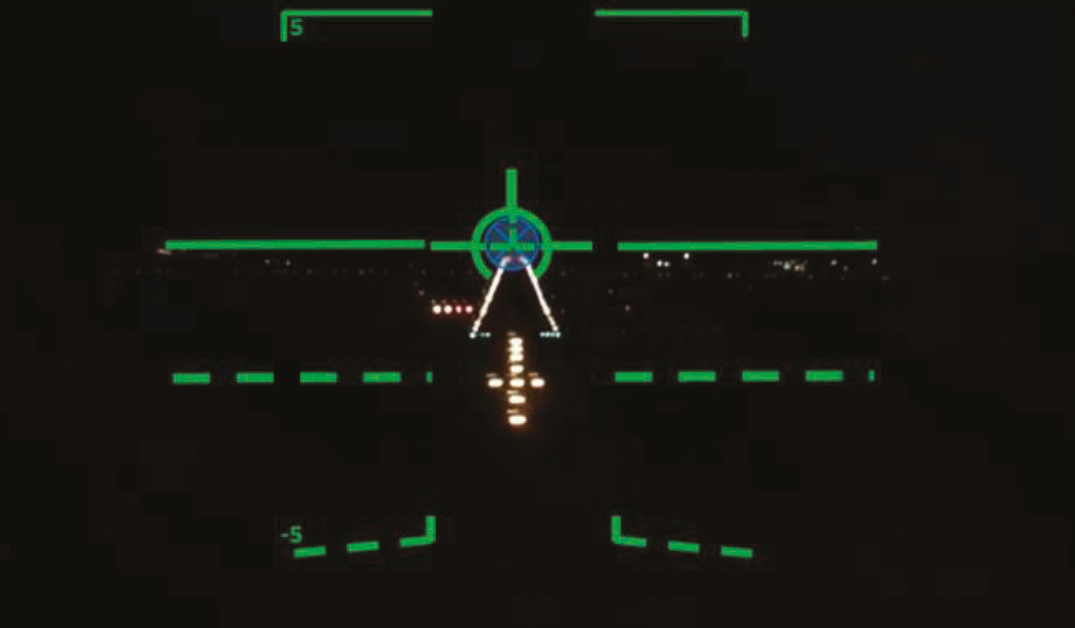
U.S. AIR FORCE
A representation of an aligned HMD.
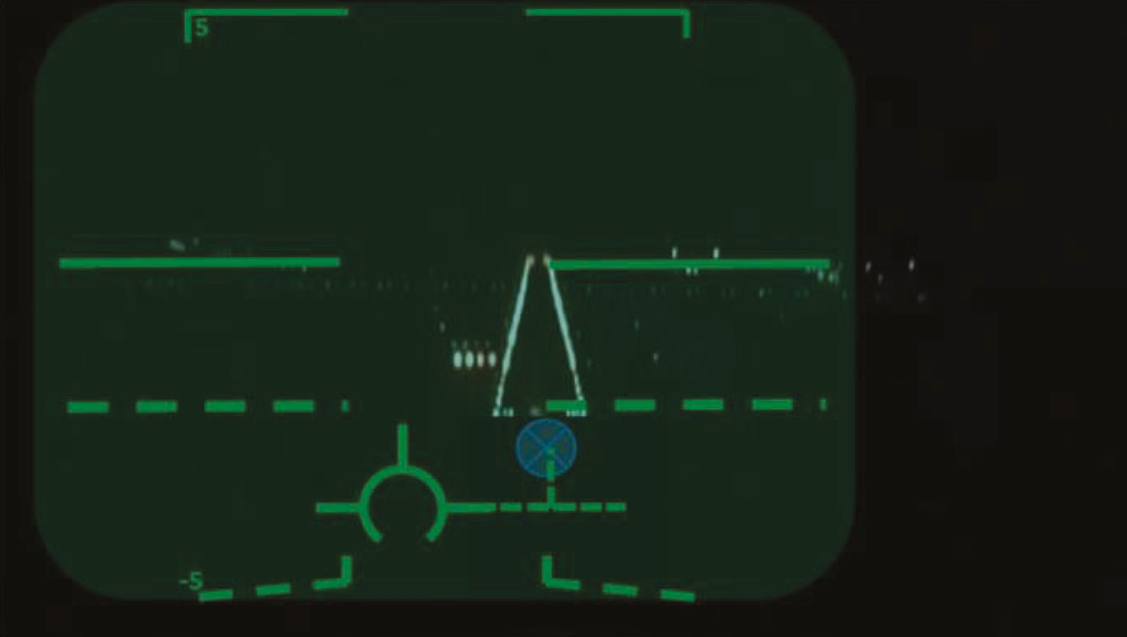
U.S. AIR FORCE
A misaligned HMD with left-to-right crosswind, “Green Glow,” and aim point in the “black abyss.”
Available data indicated to the pilot that the fighter’s glide path was too high, and the jet’s attitude needed correcting, being too nose-down for a landing. In his efforts to correct this, the misaligned display readings became even more confusing.
The accident report identified the HMD misalignment as the “critical confounding item that ultimately resulted in over-saturation” of the pilot. It records the fact that the pilot had previously experienced misalignment with the HMD, and maintainers had addressed these issues on the ground, but, without modifications, there was no way of checking alignment once in the aircraft.
In addition, the pilot had never experienced this HMD error before at night, let alone during a critical stage of flight, such as a landing. Furthermore, the report reveals, “simulator profiles train F-35 crews to fly HMD-out approaches, but do not emphasize HMD-misaligned approaches.”
The report also notes that the onboard oxygen system in the F-35 differs from those used in other Air Force jets, meaning that “many pilots across the F-35 platform […] report feeling more fatigued than normal, when compared to their prior legacy aircraft.”
When asked by investigators to rate his level of mental fatigue on a scale of one to ten, the pilot reported “a four out of ten” on a routine basis, but on the night of the mishap he reported a “six out of ten.” The report also raised the issue of emerging research into an F-35A physiological consideration called “work of breathing” — the physiological toll taken on a pilot’s cognitive capacities as a result of breathing through the jet’s unique oxygen system.
These facts, specifically highlighted by the accident investigation board, are worrying, especially given the number of U.S. military aircraft incident in recent years that have been connected in one way or another to oxygen systems.
The pilot maintained the same speed throughout the approach and landing, meaning the jet touched down on Eglin’s runway 30 around 50 knots faster than normal. At the same time, when it touched down, the jet was approximately eight degrees shallower than it should have been — an angle of attack of 5.2 degrees.
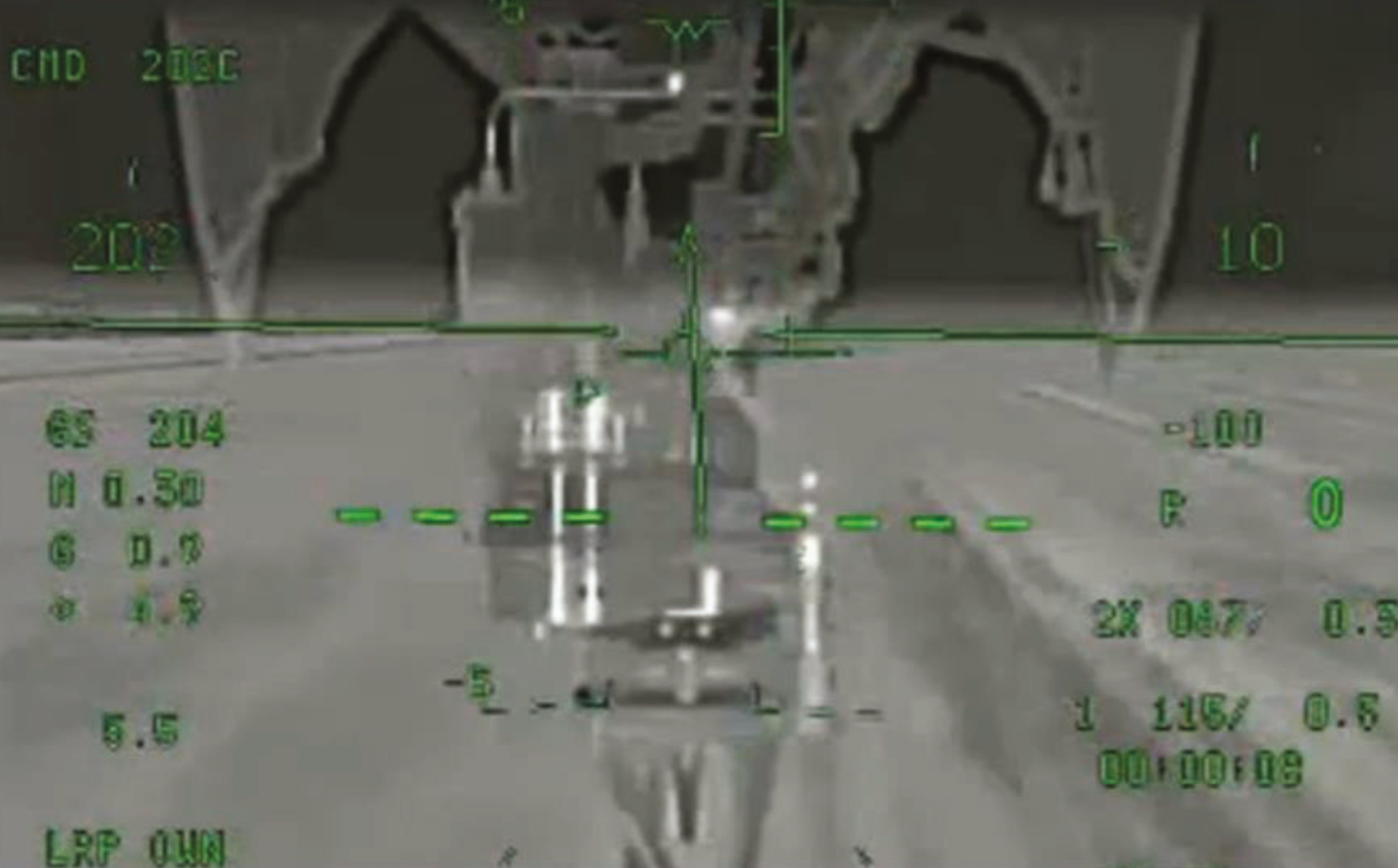
U.S. AIR FORCE
The incorrect landing attitude as seen through the F-35’s Distributed Aperture System (DAS).
While a speed of 202 knots was appropriate for the approach to the airfield, the pilot should have disengaged the speed hold, reducing velocity for the landing. Leaving the speed hold engaged was a prohibited maneuver, although there are no “audible warnings” that this was dangerous.
As the jet continued down the runway at this higher than approved speed, the pilot had to push the stick forward to bring the jet’s nose down, which had the result of what was almost a three-point landing — when the wheels on all three landing gear legs touch down simultaneously.
The nose gear, which would normally be the last to contact the ground runway, now bounced, throwing the F-35’s nose up violently. As the pilot attempted to push the stick forward again in an effort to bring the fighter to a stop, the pitch oscillations became “increasingly violent.”
A rapid succession of stick movements from the pilot then followed, in an effort to recover and set a landing attitude. As the report states, “the MP’s stick inputs quickly fell out of synch with the aircraft pitch oscillations and aircraft control cycles.” These multiple inputs overburdened the jet’s computerized flight-control system in which a glitch subsequently meant that the trailing edges of the horizontal stabilizers were deflected down and locked, which in turn pushed the nose down.
When questioned, neither the mishap pilot nor other experienced F-35 instructor or test pilots were familiar with “some of the details of the control logic,” the report explained. It also highlighted how the complexity of the jet’s flight-control logic is such that it’s impossible to train pilots on every possible scenario. “F-35A simulator models do not accurately represent the aircraft flight dynamics seen in this scenario,” it stated. Furthermore, the simulator allows for high-speed landings and the aircraft can be consistently recovered in the simulator, even after bouncing. At least two members of the accident investigation team were able to successfully land the jet in the simulator when replicating the speed and attitude of the Eglin mishap. You can read all about the extremely complex software and subsystems that make-up fly-by-wire flight control systems and how the pilot is just a voting member of those systems in this War Zone article.
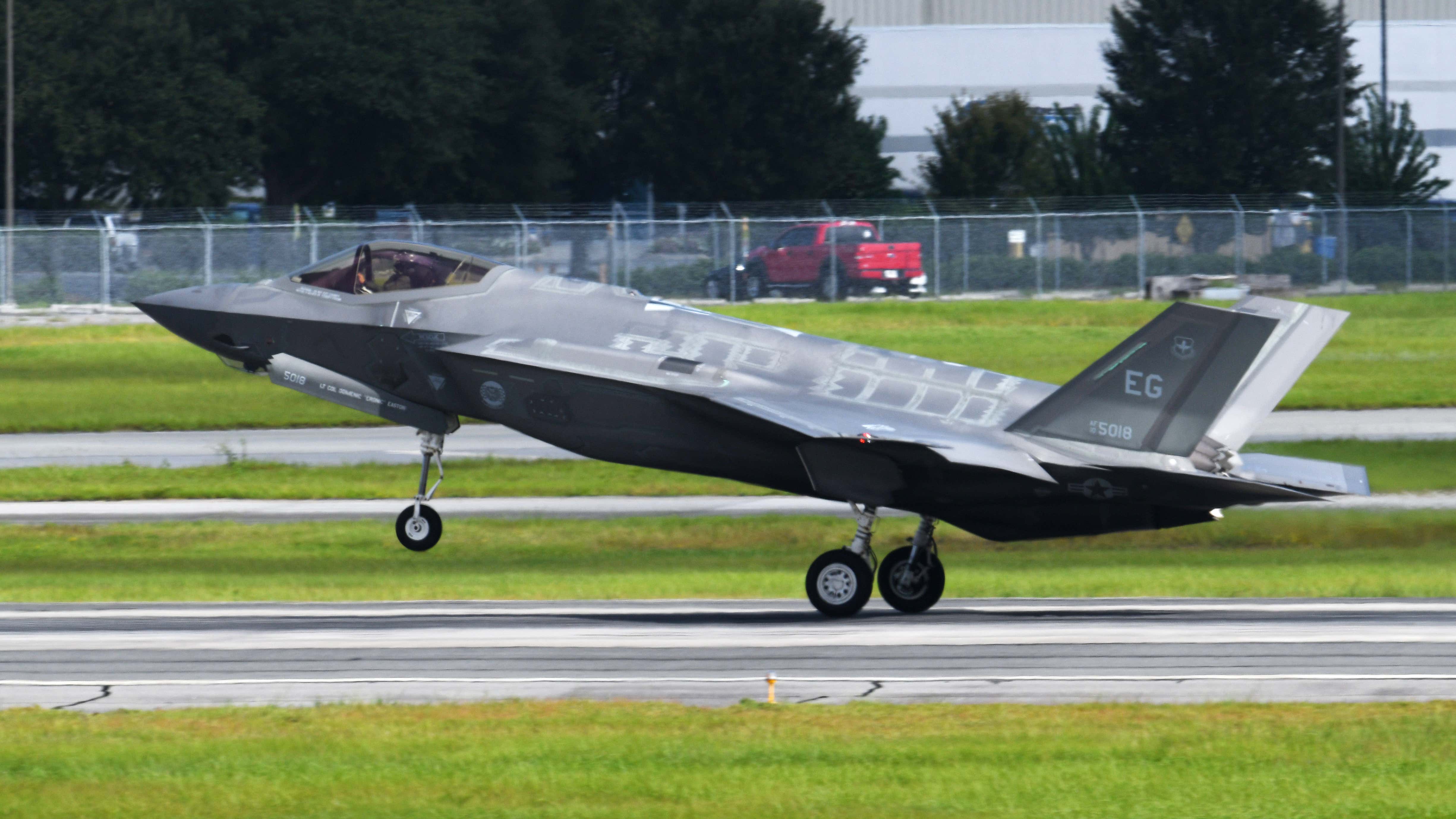
USAF
The pilot’s final effort to recover the jet saw him hold the stick aft, which would normally bring the nose back up, and then select full afterburner on the jet’s F135 engine in an attempt to abort the landing and get back in the air for another landing attempt. Take-off, however, was made impossible by the fully deflected stabilizers, which kept the nose down.
Only five seconds passed between when the tires hit the tarmac and the pilot’s ejection, which he initiated as the aircraft continued to bounce down the runway.
The jet, which the accident report valued at $175,983,949, “rolled, caught fire, and was completely destroyed,” leaving debris strewn across the runway, making it a Class A accident, the most severe category. Class A mishaps involve incidents that result in more than $2 million in damage, a fatality or a permanently disabled servicemember, or any combination thereof.

U.S. AIR FORCE/STAFF SGT. PETER THOMPSON
A 33rd Aircraft Maintenance Squadron crew chief marshals an F-35A at Eglin Air Force Base, Florida.
We often hear a lot about how the F-35 is an easier aircraft to fly than previous-generation fighters. One test pilot went as far as to say it was “the easiest aircraft I’ve ever flown in my life.” Comments from the pilot involved in the May 19, 2020, accident present a different picture. The aviator reflected that he was not only fatigued at the time of the crash, and had been suffering increasingly poor sleep, but also that he found the F-35 to be significantly more tiring to operate than his previous aircraft, the F-15E Strike Eagle.
In an interview for Air & Space Magazine, one F-15E-turned-F-35 pilot provides an interesting comparison between flying the two jets. “The transition from a fourth-gen fighter to a fifth-gen fighter was like learning how to drive an automatic car from a manual. The F-35 actually handles a lot like the F-15E, with the difference being, the F-35 is a high angle-of-attack fighter with advanced control logic. Those of us not used to low-speed, high-AOA performance from our previous aircraft must practice and adapt to those flight regimes.”
The accident report also notes that the pilot had additional tangential distractions on his mind that added to the here-and-now worry about the HMD. A day earlier, for example, the pilot was notified of exposure to the COVID-19 virus and was awaiting a colleague’s test results to determine his susceptibility.
In the report, the pilot notes other more immediate distractions too, including a poorly lit runway area that meant he had to “point into the black abyss” to get his jet back onto the runway. At the same time, this was compounded by the aforementioned green glow issue.
For all the advances that it brings with it, the F-35 program has presented its fair share of challenges and its path to the front line has been anything but smooth. The loss of this example from the 58th Fighter Squadron last summer is a reminder of the complexities inherent in the jet — and the fact that flying fast jets will always involve a degree of risk.
The cold reality is that automation and technological advances that make tactical aircraft easier to fly also make them harder to fully understand and to operate effectively when things all don't work perfectly as advertised. An over-reliance on simulators for training has its compounding pitfalls, as well, just as fleet pilots have warned of. This is especially true when those simulators inadequately reflect what would actually happen in the air, as was the case in this mishap. When it comes to manned tactical aviation, experience in the cockpit remains absolutely essential, especially when flying an aircraft that we are still trying to understand nearly a decade and a half after it first took to the skies.

 www.thedrive.com
www.thedrive.com
The pilot of the U.S. Air Force F-35A stealth fighter that crashed at Eglin Air Force Base in Florida this past summer struggled with an extraordinary catalog of problems before he ejected from the jet. Though high-landing speed was determined to be the key culprit, issues with the pilot’s helmet, the aircraft’s oxygen system, and the software behind the jet’s fly-by-wire flight control system all contributed to the accident, according to a recently released official report.
The F-35A from the 58th Fighter Squadron, the “Gorillas,” part of the 33rd Fighter Wing, crashed upon landing at the Florida base on May 19, 2020, after a routine night-training sortie. It was the second crash of a stealth fighter operating out of the base in less than a week, following the loss of an F-22 Raptor on May 15, and the two accidents led to a “safety pause” on flying operations at the base.
In its conclusion to the report, the Accident Investigation Board President, Colonel Bryan T. Callahan, makes it clear that no fewer than six factors led to the loss of the F-35. The key factor to come out of the investigation was the fact that the pilot was attempting to land the Lightning II at an excessive speed. However, the tail was also unresponsive due to a problem with the flight-control logic that wasn’t widely known up to that point.
There are other disturbing issues outlined in the final report, among them numerous errors made by the pilot — a qualified instructor who was flying as lead for the two-ship training sortie — in the run-up to the crash. The aviator was fatigued, in part due to issues with the jet’s “on-demand” oxygen system, leading to “cognitive degradation,” while a misaligned helmet-mounted display meant that he was distracted at a critical point, as well.
After ejecting, the pilot sustained non-life-threatening injuries and was transported to the 96th Medical Group Hospital for evaluation and monitoring.

U.S. AIR FORCE/SENIOR AIRMAN CASSIDY WOODY
Weapons load crew from the 33rd Fighter Wing prepare an F-35A at Eglin Air Force Base, Florida.
Exactly how the third F-35 crash unfolded is worth looking at in more detail, with a close examination of the accident report.
At the controls of the F-35A in question, serial 12-005053, the mishap pilot (MP) maintained a steady speed of 202 knots on the approach — this was correct for this phase of flight, but would be a major contributor in the accident later on. Meanwhile, problems were beginning to make themselves known, distracting the pilot from the task at hand.
First, the pilot noticed that his helmet-mounted display (HMD) seemed to be misaligned in relation to the horizon. The F-35 does not have a traditional fixed head-up display (HUD), as found on a typical legacy fighter, but instead projects that data directly onto the helmet’s visor. The Joint Strike Fighter has had issues in the past with its HMD, including with the alignment and clarity of the information presented.
“The MP was fixated on the faulty symbology of the HMD at a critical phase of flight to the exclusion of a crosscheck of either AOA or airspeed,” the report noted.
As well as the misalignment, the pilot was struggling with what seemed like excessive brightness, making it more difficult to focus. This was a result of the “green glow” phenomenon in the cockpit, created by the HMD’s projection brightness, and now made worse since it was combined with local humidity. “The [pilot] reported having to squint through the green glow in order to pick up on the environmental cues in the runway environment,” the report stated.
After checking the virtual head-up display against data from the instrument landing system, he then adjusted his aim point and glideslope as the jet neared the runway threshold.

U.S. AIR FORCE
A representation of an aligned HMD.

U.S. AIR FORCE
A misaligned HMD with left-to-right crosswind, “Green Glow,” and aim point in the “black abyss.”
Available data indicated to the pilot that the fighter’s glide path was too high, and the jet’s attitude needed correcting, being too nose-down for a landing. In his efforts to correct this, the misaligned display readings became even more confusing.
The accident report identified the HMD misalignment as the “critical confounding item that ultimately resulted in over-saturation” of the pilot. It records the fact that the pilot had previously experienced misalignment with the HMD, and maintainers had addressed these issues on the ground, but, without modifications, there was no way of checking alignment once in the aircraft.
In addition, the pilot had never experienced this HMD error before at night, let alone during a critical stage of flight, such as a landing. Furthermore, the report reveals, “simulator profiles train F-35 crews to fly HMD-out approaches, but do not emphasize HMD-misaligned approaches.”
The report also notes that the onboard oxygen system in the F-35 differs from those used in other Air Force jets, meaning that “many pilots across the F-35 platform […] report feeling more fatigued than normal, when compared to their prior legacy aircraft.”
When asked by investigators to rate his level of mental fatigue on a scale of one to ten, the pilot reported “a four out of ten” on a routine basis, but on the night of the mishap he reported a “six out of ten.” The report also raised the issue of emerging research into an F-35A physiological consideration called “work of breathing” — the physiological toll taken on a pilot’s cognitive capacities as a result of breathing through the jet’s unique oxygen system.
These facts, specifically highlighted by the accident investigation board, are worrying, especially given the number of U.S. military aircraft incident in recent years that have been connected in one way or another to oxygen systems.
The pilot maintained the same speed throughout the approach and landing, meaning the jet touched down on Eglin’s runway 30 around 50 knots faster than normal. At the same time, when it touched down, the jet was approximately eight degrees shallower than it should have been — an angle of attack of 5.2 degrees.

U.S. AIR FORCE
The incorrect landing attitude as seen through the F-35’s Distributed Aperture System (DAS).
While a speed of 202 knots was appropriate for the approach to the airfield, the pilot should have disengaged the speed hold, reducing velocity for the landing. Leaving the speed hold engaged was a prohibited maneuver, although there are no “audible warnings” that this was dangerous.
As the jet continued down the runway at this higher than approved speed, the pilot had to push the stick forward to bring the jet’s nose down, which had the result of what was almost a three-point landing — when the wheels on all three landing gear legs touch down simultaneously.
The nose gear, which would normally be the last to contact the ground runway, now bounced, throwing the F-35’s nose up violently. As the pilot attempted to push the stick forward again in an effort to bring the fighter to a stop, the pitch oscillations became “increasingly violent.”
A rapid succession of stick movements from the pilot then followed, in an effort to recover and set a landing attitude. As the report states, “the MP’s stick inputs quickly fell out of synch with the aircraft pitch oscillations and aircraft control cycles.” These multiple inputs overburdened the jet’s computerized flight-control system in which a glitch subsequently meant that the trailing edges of the horizontal stabilizers were deflected down and locked, which in turn pushed the nose down.
When questioned, neither the mishap pilot nor other experienced F-35 instructor or test pilots were familiar with “some of the details of the control logic,” the report explained. It also highlighted how the complexity of the jet’s flight-control logic is such that it’s impossible to train pilots on every possible scenario. “F-35A simulator models do not accurately represent the aircraft flight dynamics seen in this scenario,” it stated. Furthermore, the simulator allows for high-speed landings and the aircraft can be consistently recovered in the simulator, even after bouncing. At least two members of the accident investigation team were able to successfully land the jet in the simulator when replicating the speed and attitude of the Eglin mishap. You can read all about the extremely complex software and subsystems that make-up fly-by-wire flight control systems and how the pilot is just a voting member of those systems in this War Zone article.

USAF
The pilot’s final effort to recover the jet saw him hold the stick aft, which would normally bring the nose back up, and then select full afterburner on the jet’s F135 engine in an attempt to abort the landing and get back in the air for another landing attempt. Take-off, however, was made impossible by the fully deflected stabilizers, which kept the nose down.
Only five seconds passed between when the tires hit the tarmac and the pilot’s ejection, which he initiated as the aircraft continued to bounce down the runway.
The jet, which the accident report valued at $175,983,949, “rolled, caught fire, and was completely destroyed,” leaving debris strewn across the runway, making it a Class A accident, the most severe category. Class A mishaps involve incidents that result in more than $2 million in damage, a fatality or a permanently disabled servicemember, or any combination thereof.

U.S. AIR FORCE/STAFF SGT. PETER THOMPSON
A 33rd Aircraft Maintenance Squadron crew chief marshals an F-35A at Eglin Air Force Base, Florida.
We often hear a lot about how the F-35 is an easier aircraft to fly than previous-generation fighters. One test pilot went as far as to say it was “the easiest aircraft I’ve ever flown in my life.” Comments from the pilot involved in the May 19, 2020, accident present a different picture. The aviator reflected that he was not only fatigued at the time of the crash, and had been suffering increasingly poor sleep, but also that he found the F-35 to be significantly more tiring to operate than his previous aircraft, the F-15E Strike Eagle.
In an interview for Air & Space Magazine, one F-15E-turned-F-35 pilot provides an interesting comparison between flying the two jets. “The transition from a fourth-gen fighter to a fifth-gen fighter was like learning how to drive an automatic car from a manual. The F-35 actually handles a lot like the F-15E, with the difference being, the F-35 is a high angle-of-attack fighter with advanced control logic. Those of us not used to low-speed, high-AOA performance from our previous aircraft must practice and adapt to those flight regimes.”
The accident report also notes that the pilot had additional tangential distractions on his mind that added to the here-and-now worry about the HMD. A day earlier, for example, the pilot was notified of exposure to the COVID-19 virus and was awaiting a colleague’s test results to determine his susceptibility.
In the report, the pilot notes other more immediate distractions too, including a poorly lit runway area that meant he had to “point into the black abyss” to get his jet back onto the runway. At the same time, this was compounded by the aforementioned green glow issue.
For all the advances that it brings with it, the F-35 program has presented its fair share of challenges and its path to the front line has been anything but smooth. The loss of this example from the 58th Fighter Squadron last summer is a reminder of the complexities inherent in the jet — and the fact that flying fast jets will always involve a degree of risk.
The cold reality is that automation and technological advances that make tactical aircraft easier to fly also make them harder to fully understand and to operate effectively when things all don't work perfectly as advertised. An over-reliance on simulators for training has its compounding pitfalls, as well, just as fleet pilots have warned of. This is especially true when those simulators inadequately reflect what would actually happen in the air, as was the case in this mishap. When it comes to manned tactical aviation, experience in the cockpit remains absolutely essential, especially when flying an aircraft that we are still trying to understand nearly a decade and a half after it first took to the skies.

All The Ways The F-35 Tried To Kill Its Pilot Prior To Eglin AFB Crash
Six total factors, including speed, helmet, oxygen, and flight control problems, led to this summer’s loss of an Air Force Lightning II.

